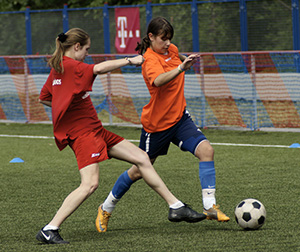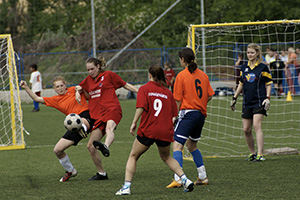Neuroscience For Kids
Concussions in Female Middle School Soccer Players
March 14, 2014
 Middle
school girls who play soccer suffer more concussions than older athletes
and they frequently continue to compete even after they suffer
concussions. This is conclusion of a research team lead by Dr. John
O'Kane (University of Washington Sports Medicine Clinic, Seattle, WA) that
examined the incidence of concussions in a group of 351 girl soccer
players (11-14 years old) in two seasons.
Middle
school girls who play soccer suffer more concussions than older athletes
and they frequently continue to compete even after they suffer
concussions. This is conclusion of a research team lead by Dr. John
O'Kane (University of Washington Sports Medicine Clinic, Seattle, WA) that
examined the incidence of concussions in a group of 351 girl soccer
players (11-14 years old) in two seasons.
The research team documented 59 concussions in the soccer players; eight players suffered two concussions. Most of the concussions (86.4%) occurred during a game and just over half of the concussions (54.3%) were caused when one player made contact with another player. Heading the ball, goaltending, chasing a loose ball and getting a ball from an opponent were the most common activities that resulted in a concussion.
 The symptoms of a concussion lasted an average of 9.4 days, but some
players reported that they still had symptoms lasting more than 21 days.
After suffering a concussion, players most often said that they had a
headache (89.3%), felt dizzy (67.8%), and had trouble concentrating
(42.4%). Rarely (only 13.6%) did the head injury cause a player to lose
consciousness.
The symptoms of a concussion lasted an average of 9.4 days, but some
players reported that they still had symptoms lasting more than 21 days.
After suffering a concussion, players most often said that they had a
headache (89.3%), felt dizzy (67.8%), and had trouble concentrating
(42.4%). Rarely (only 13.6%) did the head injury cause a player to lose
consciousness.
Of particular concern is the high number (58.6%) of players who continued to play while they still had the symptoms of a concussion. The risk of another concussion and one with more serious effects is greatly increased if a player continues to play before recovering.
Play safe! Know the signs and symptoms of a concussion.
References and further information:
- O'Kane, J.W., Spieker, A., Levy, M.R., Neradilek, M., Polissar, N.L., Schiff, M.A., Concussion Among Female Middle-School Soccer Players, JAMA Pediatr. 2014;168(3):258-264.
- Alabama Concussion Law Signed
- Sports-Related Concussions in Youth: Improving the Science, Changing the Culture
Copyright © 1996-2014, Eric H. Chudler, University of Washington
